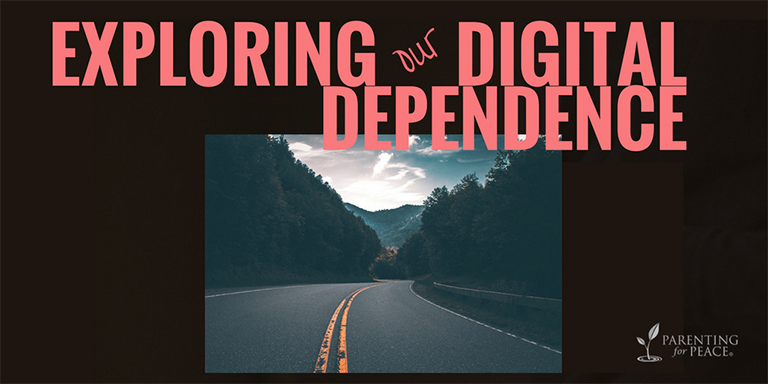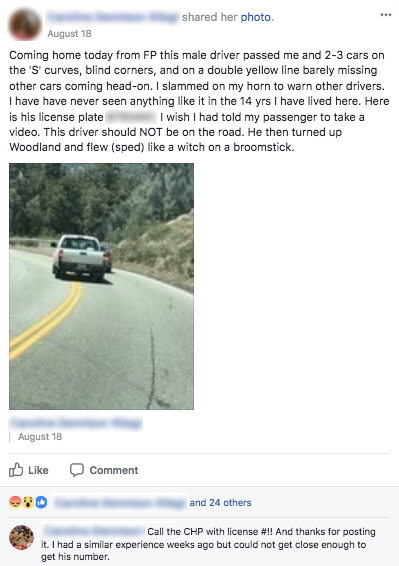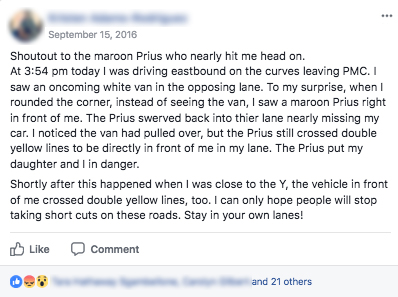
This one’s personal, folks. It’s one thing to recognize the discouraging association between smartphones and impatience, and it’s a whole other thing to experience that impatience on a daily basis in a potentially deadly way.
 Creeping along a clogged-up patch of the 101 freeway on a recent trip to Los Angeles, I was gob-smacked to see how many drivers around me were flagrantly texting – nothing covert or sneaky about it! Phones were right up in front of their faces, and apparently their one free hand — or maybe a knee — was steering.
Creeping along a clogged-up patch of the 101 freeway on a recent trip to Los Angeles, I was gob-smacked to see how many drivers around me were flagrantly texting – nothing covert or sneaky about it! Phones were right up in front of their faces, and apparently their one free hand — or maybe a knee — was steering.
I witnessed it in the lanes on either side of me, in the car in front of me, in my rear-view… seemingly all around me. It was like that classic scene out of any B horror movie: everywhere the bedeviled heroine looks, a monster looms!
But we were all moving in the same direction, we were all moving slowly, and I could change lanes to navigate away from these folks.
 In the remote forest community where I live, none of those mitigating circumstances apply on the 2-lane mountain highway we all must drive to go anywhere. To the left is a particularly infamous little section called The S-Curves. But in reality, the entire road out of our village features continuous blind curves and therefore solid double yellow lines all the way.
In the remote forest community where I live, none of those mitigating circumstances apply on the 2-lane mountain highway we all must drive to go anywhere. To the left is a particularly infamous little section called The S-Curves. But in reality, the entire road out of our village features continuous blind curves and therefore solid double yellow lines all the way.
The point of my discussion today isn’t the horribly dangerous epidemic of texting while driving, as in my above 101 Fwy example. That’s a conversation for another day. What’s been weighing heavy on my mind the past many months is the suspicion that our culture’s increasingly wired life is making (mostly young) people less patient and more impulsive in general — not just when they’re online. For example, when they’re driving our 2-lane road.
In the past couple years, two dangerous trends have become daily occurrences on this 5-mile stretch of windy road: impatient drivers aggressively tailgating, and impulsive drivers passing recklessly around blind curves.
It has become a sorely repetitive theme on our community’s Facebook group, whose posts tell the story best:

![]()

Seeing Is (Barely) Believing
The kinds of recklessness I’ve read about on our FB group defy rational comprehension. Forget neighborly concern for others: that people would put themselves in such danger is hard to fathom!
Here it is taking place right before your eyes. This is dash-cam video taken by a community member, of not one but two cars passing on a totally blind curve. (Apologies for the less-than-stellar quality: because this was posted in a closed group you cannot access, I video’d the video with my phone.)
I will grant you, that truck was going irritatingly slowly. But… but… the blind curve, the double-yellow…! And the unsuspecting oncoming motorist that so easily could have been coming toward them head-on around that bend!??
Well, one day the unexpected oncoming motorist did come around that curve, and here’s the tale she narrowly lived to tell:

Smartphones and Impatience
In the opening of this post I reference a study linking heavy smartphone use with impatience and impulsivity. But usually when I use the term “smartphone” these days, it is shorthand for “handheld digital technology” — that blinking, blipping beacon signifying instant gratification in virtually (virtually–see what I did there?) every aspect of life.
Here’s a study (admittedly small, but suggestive) that finds an association between (the instantly gratifying) streaming services (as opposed to traditional media delivery, like satellite or cable) and decreased patience. Perpetual instant gratification itself seems to have a negative effect on patience, but as with most human foibles, the need for speed (some amusing ones listed here) can be a boon for industries who exploit it.
In the bestselling anthology, What *Should* We Be Worried About?, Nicholas Carr speaks compellingly to my roiling concerns in his essay, “The Patience Deficit”:
Our gadgets train us to expect near instantaneous responses to our actions, and we quickly get frustrated and annoyed at even brief delays. I know that my own perception of time has been changed by technology. If I go from using a fast computer or Web connection to using even a slightly slower one, processes that take just a second or two longer—waking the machine from sleep, launching an application, opening a Web page—seem almost intolerably slow. Never before have I been so aware of, and annoyed by, the passage of mere seconds.
It’s not clear whether a technology-induced loss of patience persists even when we’re not using the technology. But I would hypothesize (based on what I see in myself and others) that our sense of time is indeed changing in a lasting way. Digital technologies are training us to be more conscious of and more antagonistic toward delays of all sorts—and perhaps more intolerant of moments of time that pass without the arrival of new stimuli. Because our experience of time is so important to our experience of life, it strikes me that these kinds of technology-induced changes in our perceptions can have broad consequences.
In any event, it seems like something worth worrying about, if you can spare the time.
Spare Time, Shared Fate?
Unlike in the video above, most instances of bully-tailgating and reckless passing here happen when the “slow” driver is going 35-40 mph on the curvy sections and maybe 45-50 on the (rare, brief) straightaways. This is not pussy-footed driving! Since this road is a California highway, the speed limit is technically 55 mph, but am I being frightfully old-fashioned to remember the “basic speed law”?? Does anyone recall what that is? It means only going as fast as is safe, given road and weather conditions. (Another ever-present potential road hazard up here I haven’t even mentioned is wildlife: around the next bend you could encounter a bear and her cubs crossing the road, or be startled by a deer springing directly into the path of your vehicle. Either of those = totaled vehicle and possible fatalities, human and animal.)
In that first Facebook post above, the poster mentions that in her 14 years of living up here, she had never seen anything like this. I’ve become aware of this as a persistent theme in the community discussion of the issue: people have always needed to get from here to other places on time — to work, to doctors, to weddings, funerals… and back home — but this phenomenon of aggressive impatience and reckless endangerment is new in the past 2-3 years.
I’m putting on my social-scientist hat and connecting a few data dots: 2012 was the tipping-point year for handheld digital technology, when more than 50% of people owned smartphones. As early as 2013 research was finding erosion of patience to be a side-effect of the instant gratification smartphones mediate. Meanwhile, folks up here tell me that there has been an unprecedented influx of younger full-time residents (late 20’s through early 40’s) the past few years. (This area has long been a destination for family “weekenders,” but full-timers have traditionally been older, such as retirees.)
In one of the more heated Facebook threads debating the “how slow is too slow” issue — yes, there is a faction of commenters who refer to the rudeness of slow drivers, the ones going a mere 35 mph through blind curves! — someone used a Speed/Distance/Time calculator to determine that the difference between driving 35 mph and 55 mph over that curvy 5-mile road is 3 minutes. People are risking lives acting out their “delay antagonism” (quoting Carr above) over 3 freakin’ minutes!
(And before any of my community members push back, let me state clearly that I believe there are courteous, safe younger drivers and horrible older drivers. K?? I’m casting demographics here, broad numbers and trends, not individual bits of shade.)
Tempting Fate
Someone died in a crash on the S-curves last year. And while that tragic fatality isn’t directly germane to my point today (alcohol rather than impatience was the contributing factor in the driver’s death), it lends cold-slap gravity to the matter: if someone comes at you around that next blind curve, you could die.
Officials are aware there is an issue. A couple months ago several turnouts on each side were paved, making it easier to pull over for the inevitable pushy tailgater with glaring headlights who appears from seemingly out of nowhere to ride your ass all the way down the mountain if you don’t.
A persistent theme in our Facebook group: it’s going to take someone dying in one of these incidents for people to wake up to this problem. I fear that someone will die, and the problem will continue.
I’ve come to see my quaint 2-lane highway as a social-science petri dish where dry research findings about smartphones and impatience are demonstrated in concentrated, vivid fashion. When I’m out there on what used to be our peaceful mountain road, I can’t help it: it is my morbidly dark-humor (and somewhat superstitious) style to wonder if I’m inviting a dark end. And if so, envisioning the line from my obituary: In an ironic twist of fate, Dr. Axness perished in an accident caused by the recklessly impatient, impulsive driving about which she once wrote so passionately.
All for three damn minutes.
![]()
![]()
![]()
Whether you’re curious, captivated or concerned about our digital dependence and device devotion, check out the rest of my “Wired Wednesdays” series! ….. ..
![]()
Images:
Mountain road, credit-free from unsplash
Scream Queen borrowed w/ appreciation from horrorhoneys.com
![]()
Tags: digital-dependence, driving, handheld devices, impatience, impulsiveness, impulsivity, recklessness, smartphones, technology



in control
slow down – save a life
pull over – let them go
is this my energy or yours?
what strength do i control?
pulling over slowly
is my stronger energy
you can’t
intimidate
me
driving faster
trying to blow me off the road
Ain’t hap’nin’.
I know where the
pull-outs are
and i use ‘em
you have no choice
but to speed on by.
Buh-Bye.
all you have is to
grab this pass
of mine
legally
on your side
of the double yellow lines
and drive on by.
I control who drives up my ass.
-Mindy Moffatt December 2017
Thanks, Min–spoken (artistically) by one who knows the Mil Potrero drill!
Marcy, great subject and a thoughtful post. I drive my wife, collage artist Deborah O’Keeffe, all over the Eastern U.S. for art shows, and there’s a marked change in driving etiquette the last few years. In Michigan, for example, there is a new meanness, where combative drivers intentionally mess with other drivers with incredibly risky maneuvers. In Virginia, the problem of “Trapper Keepers” bottling up traffic by driving slow in the passing lane resulted in a new state law to ticket those who intentionally delay other drivers.
The solution to the S curves is a video camera and license plate reader. It’s not difficult to set up and it’s legal. Once offenders are identified and warned or ticketed, these incidents will dramatically drop. One poor driver can be responsible for numerous near misses every day. I strongly encourage your group to get local law enforcement to followup on photos and video taken by the group.
As for the patience issue, well, we’ll just have to wait for a solution to that, won’t we. 🙂
STEVE O’KEEFE
Thank you, Steve, for your perspective on this. While it’s not good to know it’s happening elsewhere, it’s reassuring to know we’re not an anomaly! I’ll post your comment in our local group and see what folks think. (Is the set-up you’re talking about a stationary thing at a particular spot on the road, or is it a dash-mounted situation in individuals’ vehicles?)
I hope your superstition does not come true!